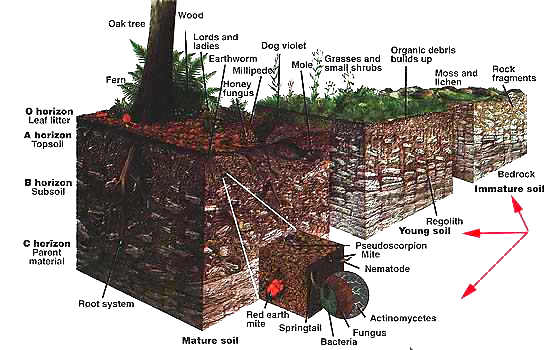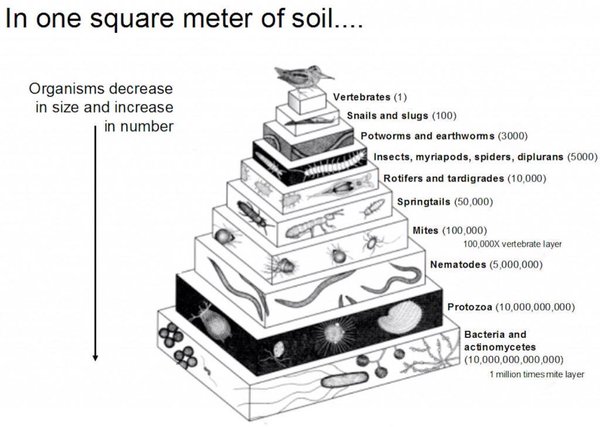In an agricultural soil is, large animals such as moles or rats excluded, a lot of life and biomass. Expressed in mass there is on earth estimated as many microbes as the mass of all of the other life combined.
Per hectare micro flora (plants) provides 10,800 kg bacteria especially around plant roots where they are responsible for the storage and processing of materials. And 10,000 kg fungi break down fibers and bind soil particles and plants. Micro fauna (animals) has 400 kg protozoa who eat bacteria and fungi.
Micro fauna (animals) has 400 kg protozoa who eat bacteria and fungi.
50 kg nematodes help with nitrogen mineralization. Centipedes, spiders and insects are good for 70 kg. Springtails are structure makers around roots and work on organic matter, together they weigh 6.5 kg. Mites, hunting on nematodes, springtails... are good for 5kg.
Earthworms that provide ventilation, drainage, nutrient transport are real soil constructors. Good for just 4,000 kg /ha!
Some organisms can continue to exist for millennia (dec 2018), 70 percent of the bacteria on the earth are underground. Five kilometers below the surface of the earth, a gigantic ecosystem exist, almost double the size of all oceans.
The heat and pressure is immense, and yet that part of the planet contains between 15 and 23 billion tons of microorganisms. Their combined weight is hundreds of times the total weight of the entire world population.
In a healthy field lives the same biomass per hectare like nematodes, bacteria and other soil organisms, as sixty sheep or five cows. In natural pastures that amount is usually even more. All these organisms concern the processing of organic material for structure and life in the soil. That biodiversity is important for agriculture and for water and carbon cycle. The richer the soil, the better the crop, the cleaner the water and the air.
Fungi consist mainly of thin, often meters long underground wires by which they transport food and water. Some species form an underground community of life with plant roots. These are the mycorrhizae. We find them mainly in forest soils and semi-natural lands. Researchers know still very little about this, but it’s clear that they are important, necessary and useful.
Nematodes are found everywhere with up to ten thousand pieces, and twenty to sixty species in our land.
They feed on all kinds of soil life. Nematode pests in agriculture arise if the ecosystem is out of balance. For example, because the same crops are used for years.
 Crane flies (especially Tipula species) lay from August to October 80 to 200 eggs. Their larvae live underground, but eat aboveground plant parts. They have a preference for dicots (so no grasses, but weeds). So they may be doing a good job in grassland. Leatherjackets, considered as a turf pest, are in the top two to three centimeters from the ground, from which they overnight stick out half from the soil, and food on the plants. You can cover the grass on a warm, humid night (after rain) with black plastic, they come up and to the morning birds (and chickens) eat them.
Crane flies (especially Tipula species) lay from August to October 80 to 200 eggs. Their larvae live underground, but eat aboveground plant parts. They have a preference for dicots (so no grasses, but weeds). So they may be doing a good job in grassland. Leatherjackets, considered as a turf pest, are in the top two to three centimeters from the ground, from which they overnight stick out half from the soil, and food on the plants. You can cover the grass on a warm, humid night (after rain) with black plastic, they come up and to the morning birds (and chickens) eat them.
White grubs are the larvae of (May, roses etc.) beetles and have 3 pairs of chest legs. They do eat grass roots. Crows, hedgehogs, foxes,... find them tasty.
Arthur Hollins of Ford Hall Farm searched for decades for a better solution, where the grass needed the animals, and the animals the grass. Where the grass turf was so firm that the animals could graze around the year. His son and daughter continue his work. Their only agricultural vehicle is a quad. To drive spread cattle back and to feed them some hay in winter. Always in a different place, so it is not contaminated, and no trample mud pits occur.
They call it Foggage Farming (forage farming = green food farming) http://www.fordhallfarm.com/fordhall_farm.php?pid=9.) Cattle lives all year round outside and only eat grass and some hay, without supplementation. That’s only possible in a varied landscape with pasture and hedgerows. The mating period is limited so that mothers get their young when there is plenty of good grass available for both. The costs and invested labor are limited, and the animals (cattle, sheep, ducks, chickens, pigs) are only (50%?) later on their slaughter weight. The system is sustainable and healthy. The animals graze in the summer in the humid valleys, and in the winter on sandy, higher ground. They never stay long in the same place.
Basically it comes down to that we are again, just like before, without imports, fertilizers and sprays, only with manure, self grow our own animal feed.
In the Low Countries, there are Grasdieren (Grass Animals) and Graskeurmerk (Grass Hallmark) with similar principles.
All animals are given adequate space, inside and especially outside. There is a diverse environment with trees and shrubs, a diversity that benefits health.
They live in small groups, e.g. straw lofts that can easily be put in another place. Concrete floors are not used, or covered with a very thick layer of straw. Pure graze is a term used for (meat of) cattle that lives all year on the pasture with tall grass.
The philosophy behind this is simple: diversity and a cycle of life. No spraying or fertilizers, no antibiotics. But a system that keeps itself alive and healthy.
The turf is seen as its own ecosystem. Like for example the Amazon, but in miniature. Instead of a virtual monoculture of five grasses (with predominantly perennial ryegrass), a variety of 20 to 30 grass species is used. Some with deep roots, others with wide ramifications. Early and late bloomers. Drought tolerant and moisture-loving grasses. Each competing atop a fertile layer teeming with micro-organisms. Together they provide a solid, living soil that can be stepped on all year round and grazed. And besides that grasses, there are also dozens of species of flowers and herbs. A varied selection from which the animals choose what they need. They are their own vet. And they find all the stuff they need.
Imagine that you need to survive yourself on a diet of potatoes. Then it will be little consolation if you can choose between four types of potatoes. Yet that is precisely the monotonous grassland which nowadays is offered to livestock.
Tansy (Tanacetum vulgare ) and St. John's wort (Hypericum perforatum) are sometimes confused with to cattle and horses very poisonous (tansy) ragwort (Jacobaea vulgaris). Sheep have an enzyme in the gastrointestinal tract that the toxic alkaloids (partly) breaks down. Avoid it in hay, because dried, horses and cattle eat it. (Fresh not quickly if there is sufficient other green.) Continue mowing (before flowering!) helps in fighting it. Or manual removal. Wear gloves, the poison works through the skin and may cause rash. By winter grazing with sheep you can get much fresh seedlings and rosettes removed.
Dig out a clod of 20 x 20 and 30 cm deep. Can you distinct layers (root, humus, clay, discoloration) in it? What is the root growth per layer? Move they down to the bottom? Go they straight down? (20 carrots is little, 200 is a lot). What is the moisture content and crumb structure by layer? How many worms can you count? 4 is okay. 3 worm holes is little, 15 is a lot.
Because of the highest possible milk production almost exclusively protein rich grasses are sown. Cows in the manufacturing companies have by this less fiber diet often diarrhea and produce typical cow pies. Dung of cattle in nature is much stronger and has more food for insects. Turds of cows on organic farms have more than 150 insects, compared to 100 bugs at "normal“ farms. Grassland birds are also the victims. Diversity in grasses is appealing to the soil, insects, small rodents, birds and cattle.
Solid manure obviously has more organic matter than slurry. Animal fertilization (unlike fertilizer) give off different fractions in a staggered time.
Grass clippings and roots provide organic matter in the soil. One percent organic matter in the soil creates additional 6 mm longer available moisture, and an increase of 25 kg N /ha /year.
Grass preferably has a pH of 5, with clover a pH of 5.5.
Clover (in grassland) can bind up to 200 kg N /ha. Without (artificial) fertilization it can yield 15 tonnes of dry matter /ha.
White clover grows only from 6-8°C and therefore appears in the spring disadvantaged. It can also spread by stolons (runners), in which each node forms a leaf stem and 2 root growth points.
Without flowers you can distinguish it from red clover because the latter has velvety hairs on the back of the leaves. Red clover has as pioneer a deep taproot and thrives on dry and on wet ground.
In mixtures of seeds for pasture and hay land is usually also chicory and plantain added.
